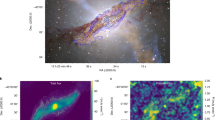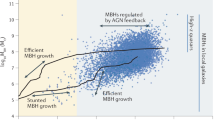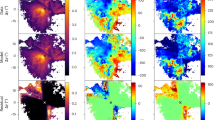Abstract
THE origin of galactic magnetic fields has been a long-standing puzzle. Models based on standard dynamo theory1–4 encounter several problems, the most fundamental of which is that, in order to explain the strengths of observed large-scale magnetic fields5–7, the fluctuating magnetic fields in galaxies must be unreasonably large8–12: the energy density in these small-scale fields must far exceed the local kinetic energy density. Here we propose an alternative mechanism of magnetic-field generation in galaxies. We show that a seed field can be generated by the rotation of an aspherical cloud of ionized gas around a central massive black hole. Strong shear flows in the rotating gas amplify this seed field, and a relatively slow galactic wind can transport the field to the outer regions of a galaxy in about 100 million years—a timescale short enough to meet the constraints imposed by the observation of strong fields in very young galaxies13,14.
This is a preview of subscription content, access via your institution
Access options
Subscribe to this journal
Receive 51 print issues and online access
$199.00 per year
only $3.90 per issue
Buy this article
- Purchase on SpringerLink
- Instant access to full article PDF
Prices may be subject to local taxes which are calculated during checkout
Similar content being viewed by others
References
Daly, R. A. & Loeb, A. Astrophys. J. 364, 451–455 (1990).
Chakrabarti, S. K. Mon. Not. R. astr. Soc. 252, 246–248 (1991).
Ratra, B. Astrophys. J. 391, L1–L4 (1991).
Rees, M. J. Q. Jl. Roy. astr. Soc. 28, 197–206 (1987).
Jaffe, W. J. Astrophys. J. 241, 925–927 (1980).
Lawler, J. M. & Dennison, B. Astrophys. J. 252, 81–92 (1982).
Krause, M. in Galactic and Intergalactic Magnetic Fields (eds Beck, R., Kronberg, P. P. & Wielebinski, R.) 187–196, (Kluwer, Dordrecht, 1990).
Parker, E. N. Astrophys. J. 401, 137–145 (1992).
Vainshtein, S. I., Parker, E. N. & Rosner, R. Astrophys. J. 404, 773–780 (1993).
Vainshtein, S. I. & Rosner, R. Astrophys. J. 376, 199–203 (1991).
Kulsrud, R. M. & Anderson, S. W. Astrophys. J. 396, 606–630 (1992).
Tao, L., Cattaneo, F. & Vainshtein, S. I. in Theory of Solar and Planetary Dynamos (eds Matthews, P. C. & Rucklidge, A. M.) (NATO ASI, Cambridge Univ. Press, 1993).
Kronberg, P. P. & Perry, J. J. Astrophys. J. 263, 518–532 (1982).
Wolfe, A. M. in QSO Absorption Lines: Probing the Universe (eds Blades, J. C., Turnshek D. & Norman, C. A.) 297–317 (Cambridge Univ. Press, 1988).
Lacy, J. H., Achterman, J. M. & Serabyn, E. Astrophys. J. 380, L71–L74 (1991).
McGinn, M. T., Sellgren, K., Becklin, E. E. & Hall, D. N. B. Astrophys. J. 338, 824–840 (1989).
Melia, F. Astrophys. J. 387, L25–L28 (1992).
Chevalier, R. Astrophys. J. 397, L39–L42 (1992).
Ozernoy, L. Ann. N.Y. Acad. Sci. 688, 596–597 (1993).
Lynden-Bell, D. Phys. Scripta 17, 185–192 (1978).
Paczynski, B. & Wiita, P. J. Astr. Astrophys. 88, 23–32 (1980).
Rees, M. J. A. Rev. Astr. Astrophys. 22, 471–506 (1984).
Biermann, L. Z. Nature 5a, 65–71 (1950).
Mestel, L. & Roxburgh, I. W. Astrophys. J. 136, 615–626 (1962).
Ciotti, L., D'Ercole, A., Pellegrini, S. & Renzini, A. Astrophys. J. 376, 380–403 (1991).
Heiles, C. A. Rev. Astr. Astrophys. 14, 1–22 (1976).
Coles, P. Comments Astrophys. 16, 45–60 (1992).
Valentijn, E. A., Perola, G. C. & Jaffe, W. J. Astr. Astrophys. Suppl. Ser. 28, 333–345 (1977).
Author information
Authors and Affiliations
Rights and permissions
About this article
Cite this article
Chakrabarti, S., Rosner, R. & Vainshtein, S. Possible role of massive black holes in the generation of galactic magnetic fields. Nature 368, 434–436 (1994). https://doi.org/10.1038/368434a0
Received:
Accepted:
Issue date:
DOI: https://doi.org/10.1038/368434a0
This article is cited by
-
Structures and Components in Galaxy Clusters: Observations and Models
Space Science Reviews (2015)
-
Numerical Simulations of the Warm-Hot Intergalactic Medium
Space Science Reviews (2008)
-
Origin of the magnetic spiral arms in the galaxy NGC6946
Nature (1996)
-
A dynamo with a difference
Nature (1994)



